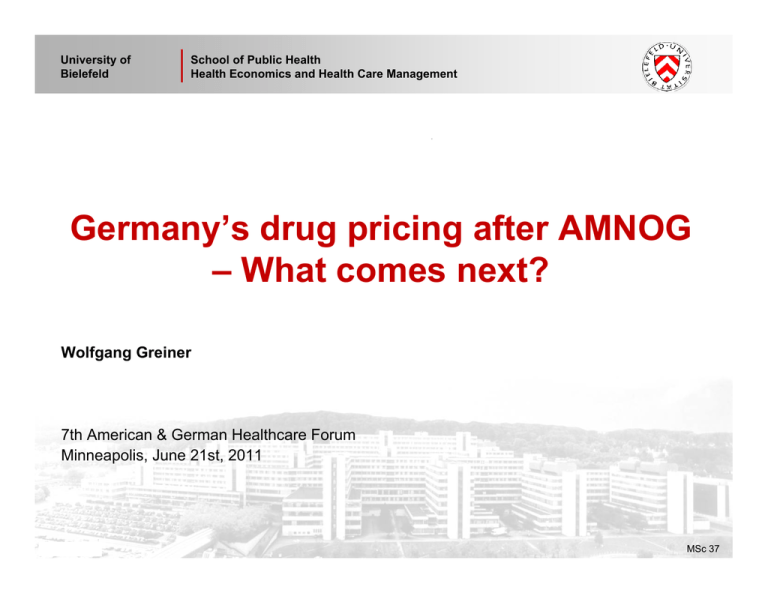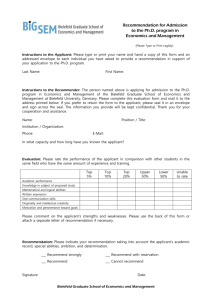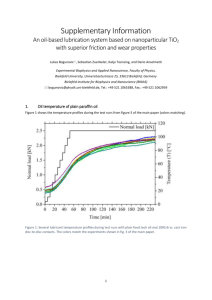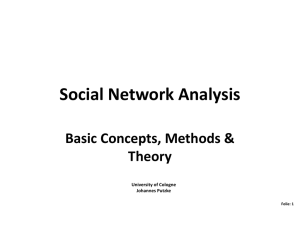Germany’s drug pricing after AMNOG – What comes next? Wolfgang Greiner
advertisement

University of Bielefeld School of Public Health Health Economics and Health Care Management Germany’s drug pricing after AMNOG – What comes next? Wolfgang Greiner 7th American & German Healthcare Forum Minneapolis, June 21st, 2011 Folie 1 MSc 37 AMNOG as a major progress in German drug regulation • Begin of value based pricing for innovative drugs with price negotiations Î end of free pricing • Explicit option to make individual contracts between sickness funds and pharmaceutical companies • Introduction of (possible) conditional reimbursement by G-BA • Consulting of manufacturer by G-BA University of Bielefeld Health Economics and Health Care Management Folie 2 Benefit as the basis for reimbursement decision University of Bielefeld Health Economics and Health Care Management Folie 3 But … still a number of shortcomings in German legislation • Price setting without formal cost-benefit analysis • Individual contracts remain the exception • Benefit assessment mainly on the basis of RCTs University of Bielefeld Health Economics and Health Care Management Folie 4 Agenda 1. Background 2. Assessment of cost and benefits 3. Real world data 4. Options to improve current drug pricing legislation in Germany University of Bielefeld Health Economics and Health Care Management Folie 5 Some prerequisites for the pure market model • No relevant market power of single players on the demand and the supply side • Total market transparency • Homogeneity of goods • Free market access and exit • No external effects and time frictions University of Bielefeld Health Economics and Health Care Management Folie 6 Basic options to regulate the market price • Value based pricing: pharmacoeconomic assessment on the basis of cost-effectiveness, e.g. Sweden und The Netherlands • Cost-plus pricing: based on cost of production, R&D, sales etc., to determine ex factory price (e.g. India, China, Pakistan) • Indirect price control (profit control), e.g. UK • External price referencing, e.g. Belgium, Italy ¾ Mixed forms very common University of Bielefeld Health Economics and Health Care Management Folie 7 External price referencing in Europe Quelle: Vogler 2011 University of Bielefeld Health Economics and Health Care Management Folie 8 Major points of discussion about CBA methods in Germany • Efficiency frontier analysis as an alternative to classical CEA with threshold • Societal perspective of analysis • Separated Assessment of cost and benefits • No additional benefit assessment by modeling • Assessment across therapeutic areas / use of QALYs Î Time for a new start ? University of Bielefeld Health Economics and Health Care Management Folie 9 Agenda 1. Background 2. Assessment of cost and benefits 3. Real world data 4. Options to improve current drug pricing legislation in Germany University of Bielefeld Health Economics and Health Care Management Folie 10 Limitations of RCTs: The five “toos” • Too few – Appr. 2,000 patients in Phase III • Too simple – Lack of co-morbidities – Lack of co-medication • Too median-aged – No children – No very old patients • Too narrow – Exactly defined indication • Too brief – Short treatment period Rogers AS, In: Pharmacoepidemiology: An Introduction. Cincinnati, 1991. University of Bielefeld Health Economics and Health Care Management Folie 11 Inclusion criteria in RCTs Proportion of patients meeting the inclusion criteria in four different RCTs for the treatment of osteporosis. Included Not included Dowd R et al. Osteoporos Int. 2000;11:533-536. University of Bielefeld Health Economics and Health Care Management Folie 12 Different benefits at different time points? Effectiveness Efficiency Efficacy Homogeneous patient groups Inhomogeneous patient groups $$$$$ „Does it work?" BLACK BOX „Is it benefitial?" University of Bielefeld Health Economics and Health Care Management ? „How about the cost benefit ratio?" Folie 13 Development of data or pieces of the value story Start Real Life Data premarket Epi/management /Cost of illness/ cost of events/ Clinical Trials Cost-effectiveness & budget impact Model Launch Real Life Data post market Comparative real life data Updating/ validating models Long term Effectiveness and safety Noe L, 2006, ISPOR Connections University of Bielefeld Health Economics and Health Care Management Folie 14 Data Sources – Clinical trials • Atypical setting, sample size, duration – Observational studies • Potential selection bias, missing values – Pragmatic trials • High costs, sample size, duration – Epidemiological studies • Selective cohorts, different objective, missing data, time factor – Data bases (e.g. claims data) • Uncertain (missing) diagnoses, miscoding, incomplete data, missing data University of Bielefeld Health Economics and Health Care Management Folie 15 Thanks for your attention • • • • • A pure market based allocation and price setting is not possible for solitaire drugs. The assessment should be valuebased. Real world data should gain more importance. CBA is necessary for the preparation of centralized price negotiations. Methods used for this official cost and benefit assessment should be monitored scientifically and externally. Contact: Prof. Dr. Wolfgang Greiner University of Bielefeld School of Public Health Health Economics and Health Care Management (AG5) P.O. Box 10 01 31 D-33501 Bielefeld / Germany Tel.: 49 (0) 521 | 106 6989 Mail: wolfgang.greiner@uni-bielefeld.de University of Bielefeld Health Economics and Health Care Management Folie 16 International price comparisons Which price should be compared? • Ex factory price • Price of gross dealers • Price ex pharmacy • Price after discount University of Bielefeld Health Economics and Health Care Management Î Reimports as alternatives? Folie 17 Why an incremental approach? • Consistent decision making for a given increase in benefits • Existing price structures of older alternatives should not determine future decisions • Inverse incentives for clinical research ¾ Incremental approach as an international health economic standard. ¾ Efficiency frontier as an additional tool to describe the current market. University of Bielefeld Health Economics and Health Care Management Folie 18 Critical comments about thresholds in Germany • No incentive to expensive R&D • Trend to me-too research • No incentive to R&D for orphan diseases • No differentiation for patient characteristics or number of treatment alternatives ¾ All these points of discussion assume a fixed, absolute threshold for the ICER (which nobody in Germany has ever suggested) University of Bielefeld Health Economics and Health Care Management Folie 19 Directions for future price regulation in Germany ¾ General remarks: • • • • Cost-benefit assessments on the basis of RCTs at market access of the drugs Reimbursement decision for 3-5 years, since then real world data collection Discussion about willingness-to-pay of the society Discussion about other criteria (social value of an innovation) ¾ Technical improvements: • • Utility, social perspective and efficiency frontier just as additional information to the decision makers Expert council to assess and improve the official methods for CBA at ministry of health University of Bielefeld Health Economics and Health Care Management Folie 20 “Social value” of treatment option Source: Drummond et al. (2007), p. 39 University of Bielefeld Health Economics and Health Care Management Folie 21







